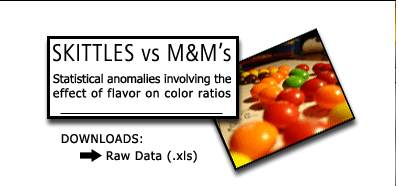 |
The following letter was sent to M&M's (Mars, Incorporated) regarding uneven distributions of flavors:
Subject: Proper distributions are off!!
Dear M&Ms,
I have recently performed an experiment involving M&Ms and then found on your website the distributions of your colors.
I welcome you to visit my website Scientific AmeriKen to view the results of this experiment. (http://www.scientificAmeriKen.com). After completing the research I found that in fact the number of blue candies in M&Ms were much lower then your website suggest. I was inquiring as to whether you could either A) Provide information of your study demonstrating M&M ratios or B) Provide an additional pack of M&Ms so that further research can be done to confirm or deny my results.
Thank you for your time and if you need my address I'll be happy to send provide.
Sincerely,
Ken Seldeen
Scientific AmeriKen
M&M's responded with the following:
In response to your email regarding M&M'S CHOCOLATE CANDIES
Thank you for your email.
Our color blends were selected by conducting consumer preference tests,
which indicate the assortment of colors that pleased the greatest number
of people and created the most attractive overall effect.
Brown is the dominating color. We believe it is selected most frequently
because it reminds consumers of chocolate.
On average, the mix of colors for M&M'S CHOCOLATE CANDIES is:
M&M'S MILK CHOCOLATE: 30% brown, 20% yellow, 10% orange, 10% green, 10%
blue and 20% red.
M&M'S PEANUT: 20% brown, 20% yellow, 10% orange, 10% green, 20% blue and
20% red.
M&M'S PEANUT BUTTER and ALMOND: 20% brown, 20% yellow, 20% green, 20% blue
and 20% red.
M&M'S CRISPY: 16.6% brown, 16.6% yellow, 16.6% orange, 16.6% green, 16.6%
blue and 16.6% red.
M&M'S KIDS MINIS: 16.7 brown, 16.7% yellow, 16.7% orange, 16.7% green,
16.7% blue and 16.7% red.
M&M'S MINI BAKING BITS: 12.50% brown, 12.875% yellow, 12.50% orange,
18.75% green, 21.875% blue and 12.50% red.
Each large production batch is blended to those ratios and mixed
thoroughly. However, since the individual packages are filled by weight on
high-speed equipment, and not by count, it is possible to have an unusual
color distribution.
Have a great day!
Your Friends at Masterfoods USA
A Division of Mars, Incorporated
To our surprise M&Ms met our demand to review their procedures in determining candy ratios. It is, however, noted that the figures presented in their email differ from the information provided from their website (http://us.mms.com/us/about/products/milkchocolate/). An email was sent back informing them of this fact. To which M&Ms corrected themselves with one last email:
In response to your email regarding M&M'S CHOCOLATE CANDIES
Thank you for your email.
On average, our new mix of colors for M&M'SŪ Chocolate Candies is:
M&M'SŪ Milk Chocolate: 24% blue, 20% orange, 16% green, 14% yellow, 13%
red, 13% brown.
M&M'SŪ Peanut: 23% blue, 23% orange, 15% green, 15% yellow, 12% red, 12%
brown.
M&M'SŪ Kids MINISŪ: 25% blue, 25% orange, 12% green, 13% yellow, 12% red,
13% brown.
M&M'SŪ Crispy: 17% blue, 16% orange, 16% green, 17% yellow, 17% red, 17%
brown.
M&M'SŪ Peanut Butter and Almond: 20% blue, 20% orange, 20% green, 20%
yellow, 10% red, 10% brown.
Have a great day!
Your Friends at Masterfoods USA
A Division of Mars, Incorporated
Introduction & Materials and Methods | Results | Discussion | Additional Information
|
 |
